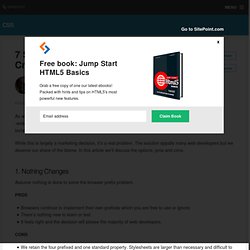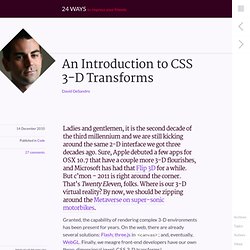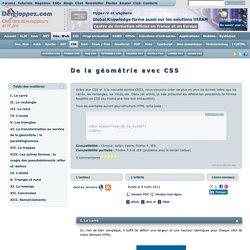

CSS 3D Lighting Engine. 7 Solutions to the CSS3 Vendor Prefix Crisis. As we reported last week Mozilla, Microsoft and Opera have become frustrated with sites which only target -webkit CSS3 properties.

It makes their browser look bad even when it implements identical or better technology. To solve the issue, they propose adding -webkit prefix support to the non-webkit browsers. While this is largely a marketing decision, it’s a real problem. The solution appalls many web developers but we deserve our share of the blame. In this article we’ll discuss the options, pros and cons. 1. Assume nothing is done to solve the browser prefix problem. Browsers continue to implement their own prefixes which you are free to use or ignore.There’s nothing new to learn or test.It feels right and the decision will please the majority of web developers. We retain the four prefixed and one standard property. 2. Adventures In The Third Dimension: CSS 3D Transforms - Smashing Coding. Advertisement Back in 2009, the WebKit development team proposed a new extension to CSS that would allow Web page elements to be displayed and transformed on a three-dimensional plane.

This proposal was called 3D Transforms, and it was soon implemented in Safari for Mac and iOS. About a year later, support followed for Chrome, and early in 2011, for Android. Outside of WebKit, however, none of the other browser makers seemed to show much enthusiasm for it, so it’s remained a fairly niche and underused feature.
That’s set to change, though, as the Firefox and Internet Explorer teams have decided to join the party by implementing 3D Transforms in pre-release versions of their browsers. That being the case, this is an ideal time to get ahead of the curve and start learning about the possibilities and potential of adding an extra dimension to your Web pages. The Third Dimension To use 3D Transforms in CSS, you’ll need to know about axes (that’s the plural of axis, not the plural of axe). An Introduction to CSS 3-D Transforms. Ladies and gentlemen, it is the second decade of the third millennium and we are still kicking around the same 2-D interface we got three decades ago.

Sure, Apple debuted a few apps for OSX 10.7 that have a couple more 3-D flourishes, and Microsoft has had that Flip 3D for a while. But c’mon – 2011 is right around the corner. That’s Twenty Eleven, folks. Where is our 3-D virtual reality? By now, we should be zipping around the Metaverse on super-sonic motorbikes. Granted, the capability of rendering complex 3-D environments has been present for years. Rationale Like a beautiful jewel, 3-D transforms can be dazzling, a true spectacle to behold. An entire application should not take advantage of 3-D transforms. Take, for instance, the Weather App on the iPhone. Flipping from details view to options view via a 3-D transition.
De la géométrie avec CSS. Grâce aux CSS et à la nouvelle norme CSS3, nous pouvons créer de plus en plus de formes telles que les carrés, les rectangles, les ronds, etc.

Dans cet article, je vais présenter les différentes possibilités de formes faisables en CSS (du moins une liste non exhaustive). Tous les exemples auront pour structure HTML cette base : Compatibilité : Chrome, Safari, Opera, Firefox 4, IE9.Compatibilité partielle : Firefox 3.5 et IE8 (problème avec le border-radius). 5 commentaires Article lu 102502 fois. Ici, rien de bien compliqué, il suffit de définir une largeur et une hauteur identiques pour chaque côté de notre élément HTML. Le principe est le même que le carré sauf que la largeur est plus grande que la hauteur (ou l'inverse selon l'effet désiré).
Le rond est obtenu grâce à la propriété border-radius sur un élément carré. J'ai appris récemment que l'on pouvait donner deux valeurs au border-radius équivalant à l'arrondi de départ et l'arrondi d'arrivée d'un coin de bordure. Par exemple :